Themed collection Editor’s Choice: 2D Materials for Energy Storage and Conversion

Two-dimensional metal–organic frameworks and their derivatives for electrochemical energy storage and electrocatalysis
The recent progress on the fabrication of two-dimensional metal–organic frameworks and their derivatives as well as their applications in electrochemical energy storage and electrocatalysis are reviewed.
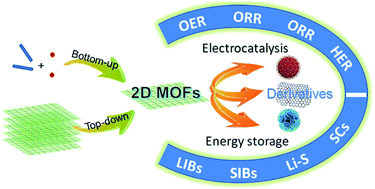
Nanoscale Adv., 2020,2, 536-562
https://doi.org/10.1039/C9NA00719A
Progress in supercapacitors: roles of two dimensional nanotubular materials
Overcoming the global energy crisis due to vast economic expansion with the advent of human reliance on energy-consuming labor-saving devices necessitates the demand for next-generation technologies in the form of cleaner energy storage devices.

Nanoscale Adv., 2020,2, 70-108
https://doi.org/10.1039/C9NA00307J
Recent advances in two-dimensional materials and their nanocomposites in sustainable energy conversion applications
Two-dimensional (2D) materials have a wide platform in technical studies and expanding nano- and atomic-level applications.

Nanoscale, 2019,11, 21622-21678
https://doi.org/10.1039/C9NR05919A
Fe2CS2 MXene: a promising electrode for Al-ion batteries
Using late transition metals and sulfur termination groups for MXene leads to 104-fold increase in Al-ion transport and 2.2-fold increase in Al-ion capacity, respectively.

Nanoscale, 2020,12, 5324-5331
https://doi.org/10.1039/C9NR08906C
Which is the most effective pristine graphene electrode for energy storage devices: aerogel or xerogel?
The morphological design of pristine graphene aerogel and xerogel in both supercapacitors and lithium-ion batteries was demonstrated.
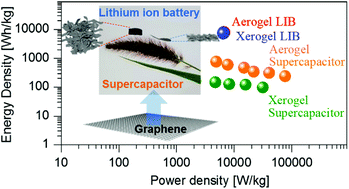
Nanoscale, 2019,11, 17563-17570
https://doi.org/10.1039/C9NR06898H
Scalable synthesis of FeS2 nanoparticles encapsulated into N-doped carbon nanosheets as a high-performance sodium-ion battery anode
Nanostructured FeS2 embedded in an N-doped carbon nanosheet composite (FeS2/CNS) was prepared and exhibited superior performance as a sodium-ion battery anode.
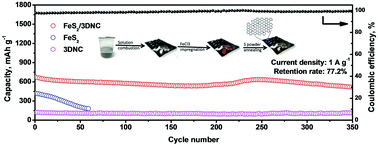
Nanoscale, 2019,11, 3773-3779
https://doi.org/10.1039/C8NR10444A
Ideal two-dimensional solid electrolytes for fast ion transport: metal trihalides MX3 with intrinsic atomic pores
Two-dimensional MX3 materials with intrinsic atomic pores are proposed as ideal solid electrolytes in ultrafast ionic and energy storage devices.
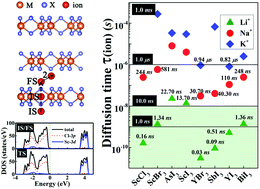
Nanoscale, 2020,12, 7188-7195
https://doi.org/10.1039/C9NR08719B
Ultrastable Li-ion battery anodes by encapsulating SnS nanoparticles in sulfur-doped graphene bubble films
SnS nanoparticles are encapsulated into sulfur-doped graphene bubble film presenting a flake-graphite-like structure. The closely packed SnS@G composite shows much lower specific surface area, smaller irreversible Li+ consumption.

Nanoscale, 2020,12, 3941-3949
https://doi.org/10.1039/C9NR10608A
N-Doped-carbon/cobalt-nanoparticle/N-doped-carbon multi-layer sandwich nanohybrids derived from cobalt MOFs having 3D molecular structures as bifunctional electrocatalysts for on-chip solid-state Zn–air batteries
Based on well-designed N-doped-carbon/cobalt-nanoparticle/N-doped-carbon nanohybrids of unique thousand-layer-cake porous structure with excellent bifunctional electrocatalytic activity, on-chip all-solid-state flexible rechargeable Zn–air batteries are developed.

Nanoscale, 2020,12, 3750-3762
https://doi.org/10.1039/C9NR09779A
Thermally reduced fluorographenes as efficient electrode materials for supercapacitors
There is an urgent need for a simple and up-scalable method for the preparation of supercapacitor electrode materials due to increasing global energy consumption worldwide.

Nanoscale, 2019,11, 21364-21375
https://doi.org/10.1039/C9NR07255A
A long-lifespan, flexible zinc-ion secondary battery using a paper-like cathode from single-atomic layer MnO2 nanosheets
Aqueous zinc ion secondary batteries (ZIBs) have recently attracted considerable attention and global interest due to their low cost, aqueous-based nature and great safety.

Nanoscale Adv., 2019,1, 4365-4372
https://doi.org/10.1039/C9NA00519F
Monolayer MBenes: prediction of anode materials for high-performance lithium/sodium ion batteries
The design and fabrication of new high-performance electrode materials are critical for driving the development of next-generation energy conversion and energy storage devices.

Nanoscale, 2019,11, 20307-20314
https://doi.org/10.1039/C9NR05708K
Encapsulation of MoSe2 in carbon fibers as anodes for potassium ion batteries and nonaqueous battery–supercapacitor hybrid devices
MoSe2/C-700 first serves as an electrode material for nonaqueous potassium-based battery–supercapacitor hybrid devices and displays an excellent specific capacity.
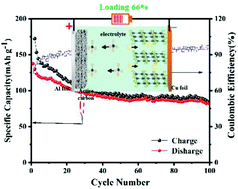
Nanoscale, 2019,11, 13511-13520
https://doi.org/10.1039/C9NR03480C
2D MXene nanosheets enable small-sulfur electrodes to be flexible for lithium–sulfur batteries
A flexible small-sulfur electrode with MXene as a conductive binder and flexible backbone is constructed combining good flexibility, stable cycling and good rate performance.

Nanoscale, 2019,11, 8442-8448
https://doi.org/10.1039/C8NR09653H
Liquid phase exfoliation of MoO2 nanosheets for lithium ion battery applications
Molybdenum dioxide (MoO2) is a layered material which shows promise for a number of applications in the electrochemical energy storage arena. This work describes the production of molybdenum dioxide nanosheets by liquid phase exfoliation.

Nanoscale Adv., 2019,1, 1560-1570
https://doi.org/10.1039/C8NA00241J
III–VI van der Waals heterostructures for sustainable energy related applications
III–VI van der Waals heterostructures are potential candidates in sustainable energy related areas.
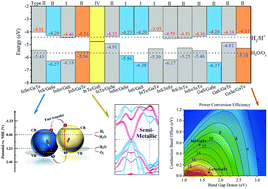
Nanoscale, 2019,11, 6431-6444
https://doi.org/10.1039/C9NR00421A
Electrochemical synthesis of NiCo layered double hydroxide nanosheets decorated on moderately oxidized graphene films for energy storage
The NiCo-LDH nanosheet arrays are strongly anchored on moderately oxidized RGO through C–O–metal bonds to construct a hierarchical composite film electrode for flexible high-performance supercapacitors.
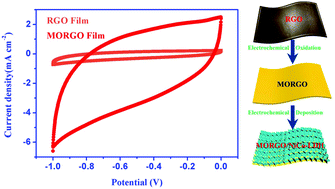
Nanoscale, 2019,11, 2812-2822
https://doi.org/10.1039/C8NR08869A
2D MXene-containing polymer electrolytes for all-solid-state lithium metal batteries
2D MXenes in solid polymer electrolytes show high efficiency in ionic conductivity enhancement and lithium metal battery performance improvement.
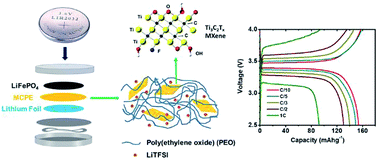
Nanoscale Adv., 2019,1, 395-402
https://doi.org/10.1039/C8NA00206A
Adsorption and diffusion of lithium polysulfides over blue phosphorene for Li–S batteries
Defect engineering of blue phosphorene in lithium–sulphur (Li–S) batteries allows for greater specific capacities and faster rate-capabilities.
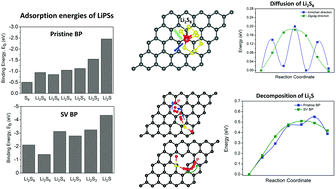
Nanoscale, 2018,10, 21335-21352
https://doi.org/10.1039/C8NR04868A
Mesoporous MnCo2S4 nanosheet arrays as an efficient catalyst for Li–O2 batteries
Ternary metal sulfides and ternary metal oxides have received much attention as potential electrodes for high performance rechargeable batteries.

Nanoscale, 2018,10, 15588-15599
https://doi.org/10.1039/C8NR03942A
Sodium storage in a promising MoS2–carbon anode: elucidating structural and interfacial transitions in the intercalation process and conversion reactions
Structural and interfacial transitions in intercalation and conversion processes on a MoS2–carbon composite are elucidated towards the fabrication of a high-performance sodium-ion capacitor.

Nanoscale, 2018,10, 11165-11175
https://doi.org/10.1039/C8NR02620C
Solvent mediated hybrid 2D materials: black phosphorus – graphene heterostructured building blocks assembled for sodium ion batteries
Solvent directed assembly of co-exfoliated 2D materials into heterostructured building blocks is introduced and combined with EPD to produce hybrid functional materials for stable high capacity sodium ion battery anodes.
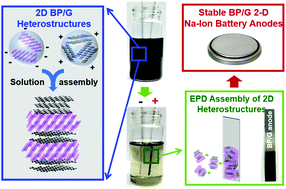
Nanoscale, 2018,10, 10443-10449
https://doi.org/10.1039/C8NR01400K
Stabilization of planar tetra-coordinate silicon in a 2D-layered extended system and design of a high-capacity anode material for Li-ion batteries
Stabilization of planar tetracoordinate silicon (ptSi) was achieved in a 2D-layered extended system, and the newly designed ptSi SiC8 siligraphene shows novel structural and electron-storage features.
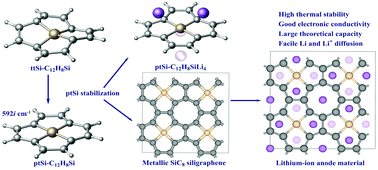
Nanoscale, 2018,10, 10450-10458
https://doi.org/10.1039/C8NR03566K
Direct growth of 2D nickel hydroxide nanosheets intercalated with polyoxovanadate anions as a binder-free supercapacitor electrode
Layered Ni(OH)2 intercalated with polyoxovanadate anions was built using a chemical solution deposition method.
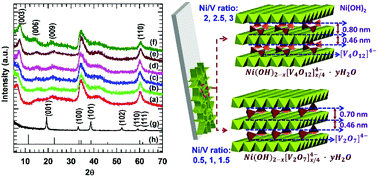
Nanoscale, 2018,10, 8953-8961
https://doi.org/10.1039/C7NR09626G
The influence of surface functionalization on thermal transport and thermoelectric properties of MXene monolayers
The structural model (i.e. adsorption site of oxygen atom on the surface of MXene) has a paramount impact on the electronic and thermoelectric properties of MXene crystals, which can be exploited to engineer the thermoelectric properties of these materials.

Nanoscale, 2018,10, 8859-8868
https://doi.org/10.1039/C7NR09144C
MoS2 nano flakes with self-adaptive contacts for efficient thermoelectric energy harvesting
We examine the potential of the low-dimensional material MoS2 for the efficient conversion of waste heat to electricity via the Seebeck effect.

Nanoscale, 2018,10, 7575-7580
https://doi.org/10.1039/C8NR01635F
Binder-free 2D titanium carbide (MXene)/carbon nanotube composites for high-performance lithium-ion capacitors
A full-cell lithium-ion capacitor is assembled using a Ti3C2Tx/CNT film as the anode and activated carbon as the cathode.

Nanoscale, 2018,10, 5906-5913
https://doi.org/10.1039/C8NR00380G
Investigating enhanced thermoelectric performance of graphene-based nano-structures
The thermoelectric performance of graphene nano-ribbons are investigated providing a route to enhance thermoelectric performance through nano-structuring.
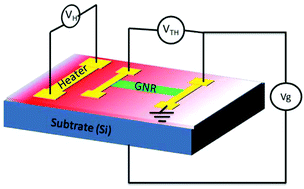
Nanoscale, 2018,10, 4786-4792
https://doi.org/10.1039/C8NR00134K
Synergetic effects of Fe3+ doped spinel Li4Ti5O12 nanoparticles on reduced graphene oxide for high surface electrode hybrid supercapacitors
High capacitance (13.2 μA h cm−2) double layer hybrid supercapacitor consisting of reduced graphene oxide/Fe doped Li4Ti5O12 (rGO/LTO) and graphite.
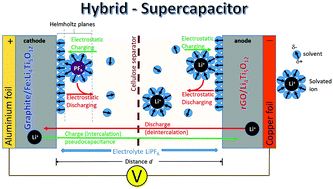
Nanoscale, 2018,10, 1877-1884
https://doi.org/10.1039/C7NR08190A
Mesoporous layered hexagonal platelets of Co3O4 nanoparticles with (111) facets for battery applications: high performance and ultra-high rate capability
High performance battery behaviour (left panel) of mesoporous layered hexagonal platelets (middle panel) composed of highly crystalline Co3O4 nanoparticles with (111) facets (right panel) in an aqueous electrolyte of 2 M KOH.

Nanoscale, 2018,10, 1779-1787
https://doi.org/10.1039/C7NR07879J
About this collection
Professor Renzhi Ma (NIMS, Japan), Associate Editor for Nanoscale and Nanoscale Advances, introduces his Editor’s Choice collection.
“The ever-growing two-dimensional (2D) material family, including graphene, phosphorene, metal oxides and hydroxides, transition metal carbides and nitrides (MXenes), transition metal borides (MBenes), metal–organic frameworks (MOFs) and so on, have garnered increasing attention due to their molecular thickness, high specific surface area and tunable physicochemical properties dependent on the structure, composition and functionalization. 2D materials and their composites have been extensively exploited to fabricate efficient electrochemical energy storage (supercapacitors, batteries) and energy conversion (fuel cells, thermoelectric devices) systems.
In this online collection, we have selected an array of 2D-energy related research articles and reviews recently published in Nanoscale and Nanoscale Advances. In addition to providing a concrete experimental demonstration for the outstanding performance, we also paid attention in picking up theoretical results forecasting the extraordinary potential of some emerging 2D materials in energy-related applications. We hope that the readers find this themed collection informative and useful.”